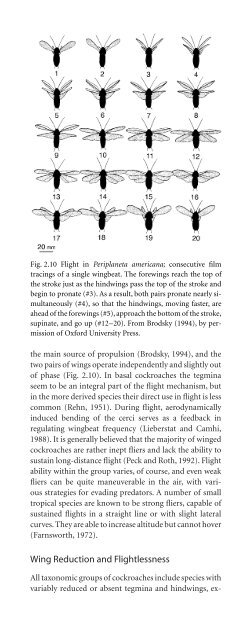Cockroache; Ecology, behavior & history - W.J. Bell
Cockroache; Ecology, behavior & history - W.J. Bell
Cockroache; Ecology, behavior & history - W.J. Bell
Create successful ePaper yourself
Turn your PDF publications into a flip-book with our unique Google optimized e-Paper software.
Fig. 2.10 Flight in Periplaneta americana; consecutive film<br />
tracings of a single wingbeat. The forewings reach the top of<br />
the stroke just as the hindwings pass the top of the stroke and<br />
begin to pronate (#3). As a result, both pairs pronate nearly simultaneously<br />
(#4), so that the hindwings, moving faster, are<br />
ahead of the forewings (#5), approach the bottom of the stroke,<br />
supinate, and go up (#12–20). From Brodsky (1994), by permission<br />
of Oxford University Press.<br />
the main source of propulsion (Brodsky, 1994), and the<br />
two pairs of wings operate independently and slightly out<br />
of phase (Fig. 2.10). In basal cockroaches the tegmina<br />
seem to be an integral part of the flight mechanism, but<br />
in the more derived species their direct use in flight is less<br />
common (Rehn, 1951). During flight, aerodynamically<br />
induced bending of the cerci serves as a feedback in<br />
regulating wingbeat frequency (Lieberstat and Camhi,<br />
1988). It is generally believed that the majority of winged<br />
cockroaches are rather inept fliers and lack the ability to<br />
sustain long-distance flight (Peck and Roth, 1992). Flight<br />
ability within the group varies, of course, and even weak<br />
fliers can be quite maneuverable in the air, with various<br />
strategies for evading predators. A number of small<br />
tropical species are known to be strong fliers, capable of<br />
sustained flights in a straight line or with slight lateral<br />
curves. They are able to increase altitude but cannot hover<br />
(Farnsworth, 1972).<br />
Wing Reduction and Flightlessness<br />
All taxonomic groups of cockroaches include species with<br />
variably reduced or absent tegmina and hindwings, exposing<br />
all or part of the dorsal surface of the abdomen.<br />
The exceptions are those groups in which the distal portion<br />
of the hindwing is set off by a transverse fold (e.g.,<br />
Diplopterinae, Ectobiinae, Anaplectinae—Rehn, 1951).<br />
Wing reduction typically affects the hindwings more than<br />
the tegmina (Peck and Roth, 1992). Even when they are<br />
reduced, wings are always flexibly joined to the thorax.<br />
Adults with reduced wings can be distinguished from<br />
older nymphs, then, because the wing pads of the latter<br />
are nonflexible extensions of the posterior margins of the<br />
wing-bearing thoracic segments (Fisk and Wolda, 1979).<br />
Although in some cockroach groups apterous species are<br />
tiny and may be passed over by collectors because they resemble<br />
nymphs (Mackerras, 1968a), some of the largest<br />
known cockroaches (Macropanesthia) also lack wings.<br />
Based on information in Rehn (1932b) and Roth and<br />
Willis (1960), Roff (1990, Table 8) estimated that more<br />
than 50% of all cockroaches and 50–60% of temperate<br />
species lack the ability to fly. Vastly different figures also<br />
have been published. Roff (1994) indicated that just 4%<br />
of cockroaches are flightless in both sexes, and 24% are<br />
sexually dimorphic, with males flying and females flightless<br />
(data from North America, French Guiana, Africa,<br />
and Malagasy). There are reasons to be cautious when assessing<br />
cockroach flight ability. First, only a fraction of the<br />
more than 4000 known cockroach species are included in<br />
these estimates; volant canopy species in particular may<br />
be underestimated. Second, flight capability in cockroaches<br />
is typically based on published descriptions of<br />
wing morphology in museum specimens. The possession<br />
of fully developed wings, however, does not necessarily<br />
mean that a cockroach can fly (Farnsworth, 1972; Peck<br />
and Roth, 1992).<br />
A more accurate measure of cockroach flight capability<br />
may lie in the color of the thoracic musculature of<br />
freshly killed insects. Kramer (1956) found that the<br />
pterothoracic musculature of apterous, brachypterous,<br />
and flightless or feebly flying macropterous cockroaches<br />
appears hyaline white, while that of strong fliers is opaque<br />
and conspicuously pink (Table 2.1). These color differences<br />
are correlated with distinct metabolic differences,<br />
as reflected in enzymatic activity and oxygen uptake<br />
(Kramer, 1956). Consequently, cockroaches with white<br />
musculature may not be able to release energy rapidly<br />
enough to sustain wing beating (Farnsworth, 1972). In<br />
cockroaches with pink musculature, the muscles of the<br />
mesothorax and metathorax are equally pigmented. One<br />
exception is the “beetle” cockroach D. punctata ( dytiscoides),<br />
which derives its common name from the fact<br />
that the somewhat reduced, hardened tegmina resemble<br />
elytra and cover a pair of long hindwings (Fig. 2.9). In this<br />
species the mesothoracic muscles are hyaline white, but<br />
the metathorax bearing the elongated hindwings con-<br />
LOCOMOTION: GROUND, WATER, AND AIR 25


